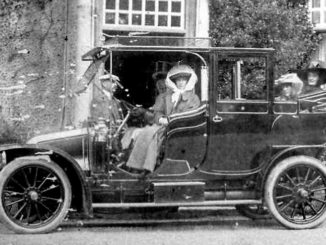
If you have a relatively modern car – definitely 20 years old or less, then you will undoubtedly have a bonded windscreen. This is where the windscreen is ‘glued’ to the car’s body and a plastic surround put on top to make it look pretty but if you look more closely, you will see something else.
Alongside the black surround on a windscreen – this is there to blend in with the black adhesive that holds the windscreen in place and so make it look far more tidy – you will see a number of black dots. Looking more closely, you will see that there are many dots near the black surround and that they become smaller and fewer in number the further you move from the black surround so what are they and what are they for?
These black dots are called frits – no, they don’t hide anybody in their basement, these provide an essential service.
Frits are made from a ceramic compound that exists inside the glass at the time of manufacture. If you think back to a time gone by, windscreens used to be held in place with a rubber surround. A piece of string with a washing up solution as a lubricant would then be used to position the windscreen glass in to a channel within the rubber surround. Although very effective, this was an expensive process. Aside from the cost, ultra violet light in sunlight eventually made the rubber brittle so losing its flexibility and making it crack. These cracks not only looked unsightly but allowed water ingress. These leaks were not always easy to see or find and often remained undiscovered until a patch of rust appeared which would be expensive and time consuming to repair. The solution was to bond the windscreen on to the car’s body. As the rubber strip used to allow a small amount of flexing, the bonded method can not – otherwise the glass would crack. This meant that car windscreen frames had to be that little bit stronger and moreso on a convertible given that their bodies flex owing to the lack of a stabilising roof.
With this problem overcome, another problem reared its head. The old fashioned rubber strip also had heat insulation properties – it did not readily conduct heat however the bonding method did and to make matters worse, the surround and adhesive was black which allowed faster and more efficient transfer of heat energy from the body of the car to the windscreen.
To solve this problem, frits were added to the glass. These allow better transfer of heat from the body to the windscreen. Although this sounds an oxymoron, what they do is reduce the temperature differential between hot and cold spots of the windscreen. This allows the windscreen to achieve a far more uniform temperature around the frame and also helps dissipate heat from the body of the car and deeper in to the windscreen. The big problem with glass is that if some areas are hot and some much less so, only the hotter areas expand whereas the colder areas will not, this deforms the glass and so makes it crack owing to an imbalance of pressures. Another benefit of frits is that of purchase. Frits give the sealant something to hold on to which ensures a far stronger bond of the adhesive to the glass as glass, as you may well know, is particularly smooth and difficult to adhere to – though the exception to this rule appears to be those annoying parking stickers you get from a supermarket or multi-storey car park.
Another thing to notice about frits is their concentration around the rear view mirror. This is simply to act as a sun blind so that when looking at the rear view mirror, the driver’s vision is not affected by the sun if it is in direct line of sight, think of this is a sort of sunshade.
So, scientifically essential for the integrity of the glass and a benefit to the driver on a sunny day, all from small dots of ceramic!
© RatCatcher 2024



